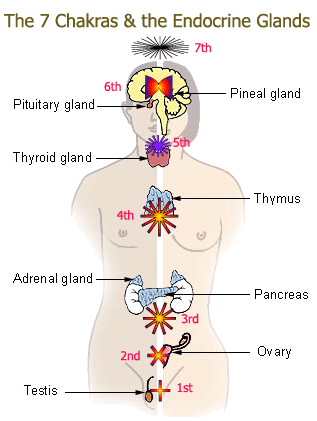 Within the human body there are almost one hundred plexuses. A plexus is a joining together (as opposed to a branching apart) of nerves forming a nerve net. The best known is the solar plexus, which is an autonomous cluster of nerve cells behind the stomach and below the diaphragm. Some scientists call the solar plexus our second brain. Other channels can form plexuses too. Blood vessels can form plexuses, such as the choroid plexus in the brain. And yogic sages tell us that nadis also form a network creating plexuses, which they call “chakras”. A chakra is literally a wheel or circle. [1]
Within the human body there are almost one hundred plexuses. A plexus is a joining together (as opposed to a branching apart) of nerves forming a nerve net. The best known is the solar plexus, which is an autonomous cluster of nerve cells behind the stomach and below the diaphragm. Some scientists call the solar plexus our second brain. Other channels can form plexuses too. Blood vessels can form plexuses, such as the choroid plexus in the brain. And yogic sages tell us that nadis also form a network creating plexuses, which they call “chakras”. A chakra is literally a wheel or circle. [1]
Chakras are models of the way the subtle energy in our bodies can be networked into gathering points, in the same way nervous energy may be net-worked in our solar plexus. Once again the student of yoga is cautioned not to believe that the models used to explain observed behavior are reality. A model is just a model; if it is useful, it is a good model.
Buddhist yogis developed one of the earliest models of the chakras fifteen hundred years ago. They helped develop the Tantra school of yoga. Being Buddhist, their model posited five chakras, one for each of the meditation Buddhas. In the Tantra school of yoga, as practiced in India by Hindu yogis, seven major plexuses were detected, one for each heavenly plane of existence (or lokahs), ranging from the earth to the highest heaven. [2]
The theories of chakras are varied and diverse. There is no consensus on the number of chakras we have (some texts describe twelve or more), their location, the description of each chakra, or even the purpose or function of chakras. Often chakras are depicted in diagrams as having a certain number of lotus petals, a particular color, sound, and symbol. But here too there is a wide diversity. What is commonly agreed is that the chakras are energy centers of the subtle body.
Chakras is not another term for the nerve plexuses or endocrine glands found in the physical body, such as the solar plexus or the ovaries, even though they may reside in the same physical location (as shown in the image on the facing page). Similarly, chakras are not to be considered physical organs of the body. Much has been made of the close proximity and similar functions of the chakras and the endocrine organs. However, the yogic texts do not make such claims, and it has been only in the last few decades that some teachers have made this association. These glands and plexuses are found outside the spine, whereas chakras are always described as being anchored in the spinal column. [3]
There are many books available today that describe chakras in detail. Tantra, the Path of Ecstasy by Georg Feuerstein has a good introduction to this topic. It is difficult to find a definitive explanation of what chakras are supposed to do, but it is safe to say that a chakra is a center of subtle energy (prana or kundalini) that needs to be manipulated in order to achieve complete physical and spiritual health, and eventually enlightenment. In ordinary individuals, the chakras are undeveloped or even dormant. The practice of yoga helps to awaken the chakras, allowing prana to flow through them. Eventually, when all six of the lowest chakras have been opened, energy is free (ayama) to reach the highest chakra, and liberation is possible.
It is time to look at each of the seven chakras individually.
- — Often it is spelled “cakra.” In fact, usually when you find a Sanskrit word translated into English with the letter “c” by itself, you can visualize a “ch” instead; the pronunciation of “c” is “ch” as in “church.”
- — It is from this hierarchy that we derive the saying “being in seventh heaven” to signify our greatest joy.
- — Dr. Motoyama’s personal investigations lead to a different understanding and a different model of the chakras. We will look at his findings a little later.
(Next: The Seven Chakras )
